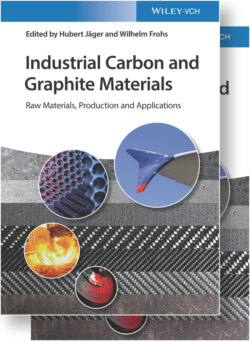Читать книгу Industrial Carbon and Graphite Materials - Группа авторов - Страница 30
3.3 Formation and Use of Natural Graphite
ОглавлениеNatural graphite occurs similar to coal in seams whose age is estimated to at least 109 years. About the genesis, biogenic and inorganic hypotheses are propounded. For most deposits organic matter as origin is assumed. Natural graphite is used since the La Tène Age by the Celts for sealing clay flagons to store and transport water and wine and for the manufacture of fireproof ceramics. At the latest since Middle Ages, natural graphite has been mined in Bavaria near Passau (mine Kropfmühl) for the manufacture of crucibles and cart grease. Since the sixteenth century, pencils have been made with natural graphite as “lead,” firstly by sheep farmers in Cumberland (England). Only in 1772 the French chemist Antoine‐Laurent de Lavoisier (1743–1794) detected by his combustion experiments with oxygen that graphite and diamonds are modifications of pure carbon and not special forms of lead and minerals, respectively.
With the development of the heavy current technique at the end of the nineteenth century, natural graphite became an important raw material because of its excellent conductive and gliding properties for the manufacturing of carbon brushes for dynamos and electric motors, carbon rods for arc lamps, and electrodes for electrochemical reactors (e.g. for production of aluminum and caustic soda). These carbon materials were made firstly through carbonization of different mixtures from purified natural graphite, with hydrofluoric acid demineralized anthracite, carbon black, and coal‐tar pitch by the German company Siemens & Halske (founded in Berlin in 1847) and the Vienna pencil‐makers Fritz and Moritz Edle von Hardtmuth together with AEG at Ratibor‐Plania in Upper Silesia (Figure 3.1) (factory founded in 1898, fusion between Siemens and Rütgerswerke in 1928 as “Siemens‐Planiawerke A.G. für Kohlefabrikate”) [4].
Today, for most of the mentioned applications, natural graphite was substituted by synthetic graphite, but some purified and selected microcrystalline, flaky, and vein types have favorable properties for special applications (e.g. refractory materials, pencils, Li‐ion batteries). The current production of natural graphite amounts to about 1 × 106 t per year with proved reserves for several hundred years, predominantly in China, Brazil, Sri Lanka, and Africa.
Figure 3.1 Siemens‐Plania factory “Schwarze Bude” at Ratibor (1928) [19, 20].
